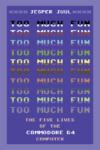Not a holiday piece, but might as well be, Linus Åkesson’s version of Ravel’s Boléro for mostly Commodore 64-derived instruments, with a floppy drive, NES, and Amiga thrown in. As always, an explosive combination of technical and musical skill, and understatedness.
My 1989 Commodore 64 X-mas Demo; Too Much Fun is 1 year old
 My Commodore 64 book, Too Much Fun, is 1 year old this December. Since the holidays are approaching, I am existentially obliged to make you consider giving it as a gift.
My Commodore 64 book, Too Much Fun, is 1 year old this December. Since the holidays are approaching, I am existentially obliged to make you consider giving it as a gift.
You know what is even older? I wrote this Commodore 64 holiday demo, “The Ghost of X-mas” in (checks watch) 1989!
I was very proud of the way the snowflakes fall individually and accumulate, yet are also moved in unison by gusts of wind.
Happy holidays!
Foundations of Digital Games 2026 Call for Papers
 We will be hosting the ACM conference Foundations of Digital Games 2026 conference here at the Royal Danish Academy in Copenhagen August 10-13 2026.
We will be hosting the ACM conference Foundations of Digital Games 2026 conference here at the Royal Danish Academy in Copenhagen August 10-13 2026.
And the call for papers is out now: https://fdg2026.org/call-for-papers/
Hope to see you (and your paper) at FDG’26.
Important Dates
All deadlines are at 11:59pm (23:59) Anywhere on Earth (AoE).
Note that due to proximity to the holidays, there will be no extensions!
• Workshop, Competition, and Panel Proposal Submissions: 21 November 2025
• Abstract Deadline (for Regular Papers): 5 December 2025
• Regular Paper Submission Deadline: 15 December 2025
• Regular Paper Notifications: 1 February 2026
• Late-Breaking Short Papers & Games/Demos Deadline: 30 March 2026
• Doctoral Consortium Deadline: 30 March 2026
Will AI Destroy Consulting?
AI Rule no. 1: Cynical writers use AI.
Will AI destroy consulting firms? I enjoy this story where Deloitte have admitted that their report on “Targeted Compliance Framework Assurance Review” for the Australian government was written partly by AI.
Long consulting reports are likely the most cynical and vacuous writing there is, so of course AI will be used.
But I sincerely wonder what this will do to consulting? Will it mean that CEOs will just use AIs for their reporting? Why would anyone pay millions for work/AI slop?
Or is it, just as likely, that consulting firms will charge even higher fees for their special human touch (still written by AI)?
For Svend Juul, 1940-2025
Svend Juul, 1940-2025
My father died this summer. He lived a long life, leaving four children and five grandchildren whom he loved dearly. He was active to the very end, updating his epidemiology textbook this spring.
My father caught a long period of history, born a month after the beginning of World War II in Denmark, seeing the German troops leave when he was five, studying medicine, becoming the first employee at the new institute of Social Medicine at the University of Aarhus in 1970, and being part of the development of the field of public health, and indeed of the Danish health care system. His most popular book is the introduction to epidemiology, now in its fourth edition.
I once asked my father why he had chosen the field of medicine? “To save the people.” He became a researcher, with a skill in study setups and statistical analysis, at first programmed on punch cards and mainframes, but always interested in how to solve problems, gather data, and gain new knowledge.
 I think I picked up two main things from him. First, that changing the world, such as by saving and helping people become healthier, requires genuine humility and curiosity: Even if you have a strong idea of how the world works – a hypothesis – you must set up a test that can prove you wrong, and you must accept the results. Though I work in a different and less immediately important field, I think about how to genuinely ask questions and how to truly take in what the world is telling me in return.
I think I picked up two main things from him. First, that changing the world, such as by saving and helping people become healthier, requires genuine humility and curiosity: Even if you have a strong idea of how the world works – a hypothesis – you must set up a test that can prove you wrong, and you must accept the results. Though I work in a different and less immediately important field, I think about how to genuinely ask questions and how to truly take in what the world is telling me in return.
Second, my father was funny, allergic to pompousness and sensitive to the ironies of life, openly annoyed by bad manuals, and he would sometimes write the new improved manual himself. I learned that it is OK to be serious and lighthearted at the same time, and that you can use your annoyance to make things better.
He was also a modest man who would contribute his statistical expertise to the work of others and worry less about citations and web presence. I have set up a page with his publications at jesperjuul.net/svendjuul
It is disorienting not being able to call my father, not being able to discuss a recent event, not being able to run a back-of-the-envelope calculation of energy efficiency, planning, or especially health by him. Part of me can simulate some of what he would say, but it really is not the same.
At the end, my father suffered from an interminable list of ailments, but he was proud when doctors confessed to having read his epidemiology textbook in class, and proud that he had taught doctors and nurses, gathered and analyzed the data, and helped build the Danish public health system that was now treating him.
Thank you
A Student/Worker’s Guide to European Google Docs / Office 365 Alternatives
What is it like to study or work professionally in 2025? Doesn’t it always involve the same setup?
You work from project to project in shifting groups. Each group shares a folder with Word documents, spreadsheets, presentations, and a host of other files. Multiple people can edit the same file at the same time. Most of the time you do this in your browser, but often you want to look up or edit something on your phone.
The Problem
For this kind of work, the world has gravitated towards Google Docs/Workspaces and Microsoft 365. But as of May 2025, this feels unsustainable. Let me state the obvious reasons:
- As the saying goes, “If it is free then you are the product”. It is a bad thing to work in tools that track and analyze you and then sell the data or use it to sell ads to you. We should demand basic privacy from our tools.
- The tech giants have too much power, and we should give them less.
- Yes: Google and Microsoft are US companies, so all your emails and documents on their services are immediately available to a slew of agencies who can scan them for keywords, and your access is not guaranteed. As privacy activist Max Schrems will tell you, local law like the European GDPR does not protect your data from US companies.
How can we work around this?
Requirements for a Google Docs/Microsoft 365 Alternative
I wrote this guide because I couldn’t find one and had to test a number of solutions for myself. I think good guides are absent because of confusion about what the requirements are. Discussions of Google Docs alternatives tend to cover mostly the nearly irrelevant (email services with notetaking) or the technically onerous (“next, set up the reverse proxy”). That’s not it. To do our project work, this is what we require:
- Editing of Word, Excel, and PowerPoint files in the browser.
- Sharing documents and folders with simultaneous editing.
- A service that you can sign up for easily.
- Free and paid tiers with transparent pricing.
- Generous storage for large projects.
- Placement in a European GDPR-covered setting (no US or US-owned companies, sorry).
- Preferred: No ads or tracking. (We should be willing to pay for our tools.)
- Preferred: App for editing on the fly.
- Preferred: Network drive (like Google Drive / Dropbox).
- Optional: Zero-Knowledge encryption, meaning that the company cannot read your documents, even if they want to.
- Optional: Integration with email.
I have tested the relevant offerings that I am aware of, uploading Word, Excel, and PowerPoint documents, and trying out sharing features. As far as I can tell, these are the worthy European Docs/Office alternatives that fit the requirements. I am not receiving any payment for these recommendations, and I may update this list if things change.
Most Complete Package: kSuite
 Good:
Good:
-Fully featured office suite and email
-Good sharing
-Network drive in pro tier
-Extras like video conferencing and a WeTransfer clone
-Best email import
-Mobile app for editing
-Europe-based AI option
Bad:
-Can be rough around the edges; occasional messages in French, and network drive sometimes needed restarting
-No zero-knowledge encryption
Pricing:
Free tier: 20/15 GB.
My kSuite: €2/month for 1TB
kSuite Pro: €6.58/month for 3TB and network drive
kSuite Pro: €12.42/month for 6TB and network drive
 I think kSuite from Swiss Infomaniak is the most complete Docs/Office alternative. It has good Word/Excel/PowerPoint compatibility, emails, and sharing of folders/documents including no-login editing (which I use in teaching contexts), in addition to video conferencing and Slack-like channels.
I think kSuite from Swiss Infomaniak is the most complete Docs/Office alternative. It has good Word/Excel/PowerPoint compatibility, emails, and sharing of folders/documents including no-login editing (which I use in teaching contexts), in addition to video conferencing and Slack-like channels.
Here, I have uploaded a moderately complex Word document from an article about the Commodore 64, which includes images and an Excel vector diagram. It works surprisingly well, but this is generally true for most of the services, as they basically use either Collabora Office or OnlyOffice (this one) as underlying tech.
Also consider the app editing the same document. kSuite is not as polished as Google Docs, but it is a serviceable and quite complete platform that you can run whole projects or organizations on.
Simple and Incomplete: Mailbox.org
![]()
 Good:
Good:
-Office suite and email with collaboration functionality
-Video conferencing
-Basic Zero-knowledge encryption for selected files
-Includes email
Bad:
-Office compatibility is incomplete
-Tiny storage allowances
-A little rough, sometimes switches to German
-No free tier means all collaborators must be on paid plans
-App does not allow editing
Pricing:
Standard: €3/month for 10/5 GB.
Premium: €9/month for 50GB.
Mailbox.org is the unfancy package that isn’t quite there. It features basic video meeting facilities, calendar, and tasks, and there is a Zero-Knowledge encryption facility for encrypting individual files with an extra password. But for practical work, the lack of a free tier means that all collaborators must be on a paid plan, the storage space is quite small, and the app does not allow editing. Also, as the image shows, the editor cannot show complicated word diagrams. Mailbox has been around for a while, but it is not quite there.
Cleanest Office Package, but with Trackers: Drime
![]()
 Good:
Good:
-Office suite with clean & modern design
-Nice group-oriented features
-Generous storage
-PDF and video editing
Bad:
-Lots of trackers on both website and app
-App only allows previews, no editing
-No email service
-Promised network drive not there yet
-No Zero-knowledge encryption
Pricing:
Free tier: 20 GB.
Starter: €2.99/month for 500GB
Essentials: €5.5/month for 2TB
Essentials: €10.99/month for 3TB
Advanced: €19.99/month for 6TB
(Plans allow multiple users.)
 Drime is a new service with a clean and modern look, as well as good onboarding and well-designed groupware features. If you want an easy-to-use office package without email, this is a good bet. Office compatibility is identical to kSuite because it uses the same underlying software (OnlyOffice), but the general design is a bit more polished.
Drime is a new service with a clean and modern look, as well as good onboarding and well-designed groupware features. If you want an easy-to-use office package without email, this is a good bet. Office compatibility is identical to kSuite because it uses the same underlying software (OnlyOffice), but the general design is a bit more polished.
My main reservations are first that Drime collects lots of data on both app and website, (for all solutions tested I am going by the official declaration on Google Play, as well as by reporting from DuckDuckGo and Privacy Badger), and second that the app only allows browsing, not editing. If you can live with those caveats, Drime is a good option.
Most Secure: CryptPad
 Good:
Good:
-Office suite with clean, modern design
-Also diagrams, Kanban (like Trello), and whiteboard
-Zero-knowledge encryption
-Good sharing options
Bad:
-No email service
-No app and no network drive
-Small storage plans, so this is just for your documents
-Two-step upload procedure
Pricing:
Free tier: 1GB
Duo: €10/month for 25GB
Team: €15/month for 75GB
(Duo and Team and have multiple users.)
If you are sufficiently worried about privacy, CryptPad is the package to get. This is a nicely designed browser-only package with Zero-knowledge encryption. To explain: the company’s server stores your files in encrypted form without the key to decrypting it, so in theory the company cannot share your files even if subpoenaed. I am assuming that your interest in this feature comes from a good place.
CryptPad Office compatibility is good (again, this is OnlyOffice under the hood), and sharing options are quite sophisticated, including time-limited sharing. There are also interesting options for shared whiteboards and Kanban (Trello-like), so this is a quite complete package for collaboration.
Bonus: Email services
Though we are used to it, we don’t have to get our office and emails from the same provider, and for the email-less packages, a separate email provider is necessary anyway. Most privacy-conscious users swear by Swiss Proton which also features a Drive and VPN, or German Tuta. Both are zero-knowledge encrypted for maximum privacy. Encryption comes with the tradeoff that search is slow and poor because the server cannot search through your encrypted mails.
Furthermore, email import in Proton and Tuta is shaky, not for technical reasons, it just is. Proton can import large email archives, but they decided that multi-level Gmail labels were not important, so a well-organized Gmail archive will end up jumbled (nested labels are not rocket science, people). Tuta’s email import also does not work well with Gmail labels and struggles with large archives. kSuite’s import was much better in this regard.
Recommendations
There it is. A complete package, some office-only packages, some very polished, some a little rough. One with many trackers, some with encryption. Some writers will notice that all the screenshots show the whitespace between pages, but you cannot hide it in any of the packages! This drives me a little crazy, having participated in the decade-long struggle to get this feature into OpenOffice.
The packages are much better than I had hoped, but there are obvious opportunities: What if kSuite added encryption for selected folders? What if Drime got rid of the trackers and added encryption? What if there was an encrypted mail service that properly imported Gmail? What if someone properly packaged Nextcloud office for end-users? For now, I believe there are three main options, depending on your needs:
- The complete package: kSuite, which includes email and collaboration.
- The polished office suite without email, but with trackers: Drime.
- The encrypted and truly privacy-conscious combination: CryptPad + Proton.
It is an individual choice whether to stick with the big tech platforms. Also consider how you feel about tracking, encryption, and convenience. I just hope to have contributed to making the choice easier. Over to you.
PS. If there is interest, I may publish a how-to-guide about practically moving your documents away from Google/Microsoft.
PPS. I excluded some services from the survey: Zoho Office (not based in Europe), Nextcloud Office, OnlyOffice, and Collabora Online (these are platforms, but not oriented towards end-users), Nuclino and Cryptee (cool, but not based on office formats). Proton Docs (more like WordPad than an office suite). Nextcloud servers are often brought up, but having tested the more polished offerings (Hosting.de, Nextcloud One, and Ionos), it is clear that they require too many complex steps for most people – the technology is there, it just needs to be packaged better – upfront pricing and feature info, English-language options, one-step install.
Spanish translation of my “Gameplay” article
Miguel Olmedo Morell has kindly made a Spanish translation of my Gameplay entry from The Johns Hopkins Guide to Digital Media.
https://jesperjuul.net/text/gameplay_es/
Interviewed in the Austrian FM4 Game Podcast
 Robert Glasshüttner kindly interviewed my about game studies and my books for Austrian FM4 radio’s Game Podcast.
Robert Glasshüttner kindly interviewed my about game studies and my books for Austrian FM4 radio’s Game Podcast.
The intro is in German, but the discussion is in English.


